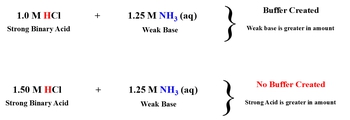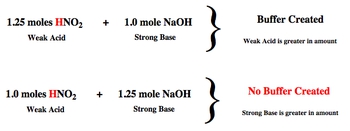Hey guys, in this new video, we're going to take our first looks at what exactly is a buffer and how exactly they work. So, we're going to say here solutions that contain a weak acid and its conjugate base. Remember, when I say weak acid, we can think of HF. Conjugate base means it has one less H+. So take off the H+, you have F-. But professors don't like to give you just F-, they'll combine that F- with a metal. So we could say our conjugate base here is NaF. So solutions which contain a weak acid like HF and a conjugate base with one less H like NaF are called buffer solutions because they resist drastic changes in pH.
Now, how do they accomplish this? Well, they do this by keeping your H+ concentration and your OH- concentration constant. It keeps them basically the same. The way this works is we're going to say adding a small amount of strong base and the pH will increase because remember, if you add base, you're going to go above 7, so you keep going up and up. But it's not going to increase by much because the weak acid will neutralize the strong base that you add. Now adding a small amount of strong acid and the pH will decrease. Again, it's not going to decrease by much because why? The conjugate base will neutralize what you add. So that's how a buffer works. Any acid or base that I add, they get reacted with either the weak acid or the conjugate base. Remember, acids and bases are natural enemies of each other. If I add base, my weak acid steps in to try to take it out. If I add acid, my conjugate base steps up and tries to take it out. That's how a buffer will work.
And remember, the only things that can destroy a buffer are by adding too much strong base or too much strong acid. Adding water to a buffer does nothing to it. Why? Because adding water changes the concentration of my weak acid but also changes the concentration of my weak base proportionally. So proportionally, the ratio would stay the same, so my buffer would be unaffected by the addition of water. So remember, adding a strong acid or base is the only way to really destroy a buffer. Adding water does nothing to it.
Now, knowing this, I want you guys to try to answer this first practice question. We're going to say, which one of the following combinations does not create a buffer? Remember, we just said above, a buffer is a weak acid and its conjugate base. So this is going to require you guys to remember the rules that we talked about in identifying compounds as either being acidic or basic, strong or weak. Once you can do that, you'll be able to guide your way to the correct answer for this one. Come back, click on the explanation button, and see the choice that I make and see if it matches up with yours.








